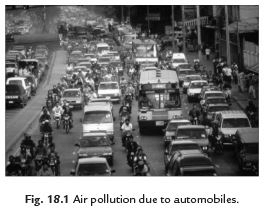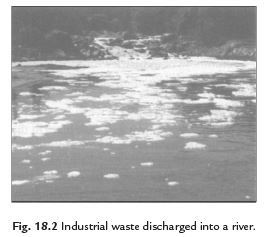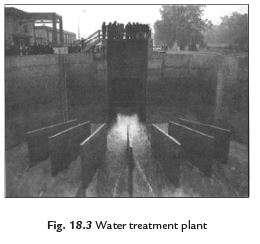Class 8 Science Question Answers - Pollution of Air and Water (Old Syllabus)
Q1: Explain Ganga Action Plan.
Ans: The Ganga action plan was, launched by Sri Rajeev Gandhi, the then Prime Minister of India on 14 Jan. 1985 with the main objective of pollution abatement, to improve the water quality by Interception, Diversion and treatment of domestic sewage and present toxic and industrial chemical wastes from identified grossly polluting units entering in to the river. The other objectives of the Ganga Action Plan are as under.
- Control of non-point pollution from agricultural runoff, human defecation, cattle wallowing and throwing of unburnt and half burnt bodies into the river.
- Research and Development to conserve the biotic, diversity of the river to augment its productivity.
- New technology of sewage treatment like Up-flow Anaerobic Sludge Blanket (UASB) and sewage treatment through afforestation has been successfully developed.
- Rehabilitation of soft-shelled turtles for pollution abatement of river have been demonstrated and found useful.
- Resource recovery options like production of methane for energy generation and use of aquaculture for revenue generation have been demonstrated.
- To act as trend setter for taking up similar action plans in other grossly polluted stretches in other rivers.
Q2: Clear transparent water is always fit for drinking, do you agree?
Ans: No, clear and transparent water is not always fit for the purpose of drinking. There are possibilities of disease causing microbes and dissolved impurities in the clear and transparent water. So, it is important to purify water before drinking , water can be purified by using water purifiers, by chlorination and by boiling.
Q3: Explain air pollution and its harmful effects. Also list some important measures to reduce air pollution.
Ans: Air pollution cab be reduced by adopting following ways:
- Reduce the use of car and other vehicles as these are the significant source of air pollution, so switching to a more gas-efficient vehicle will be a big help. Taking public transport to work rather than driving will reduces the number of carbon dioxide into the air. Using eco-friendly fuels in vehicles like CNG can also be beneficial.
- Reduce Waste: Manufacturing of unnecessary or disposable goods often produces air pollution, so reduced purchasing of disposables will help. In general, follow the solid waste mantra - "Reduce, Reuse, Repair, And Recycle" - and this will reduce air pollution as well from transporting, treating, or disposing of unnecessary wastes.
- Eliminate Toxic Chemical Use at Home --- A surprising number of household or home shop chemicals are toxic and volatile. Many release vapours into the air, inside the home and out. This can be serious health threat to your family, and contributes to community-wide levels of air pollutants.
- Plant leafy trees and shrubs --- Deciduous trees and shrubs (the kinds that drop leaves in the fall) are excellent air filters to help reduce smog and cool the air on hot summer days.
Air pollution is a significant risk factor for multiple health conditions including respiratory infections, heart disease, and lung cancer. The health effects caused by air pollution may include difficulty in breathing, wheezing, coughing and aggravation of existing respiratory and cardiac conditions.
Q4: What is air pollution? Write its causes.
Ans. When air is contaminated by unwanted substances which have a harmful effect on both the living and non-living, it is called air pollution.
Causes of air pollution:
(i) Vehicles: Vehicles produce high level of pollutants like carbon dioxide, carbon monoxide, nitrogen oxides and smoke. Carbon monoxide is produced from incomplete burning of fuels such as petrol and diesel. It is a poisonous gas. It reduces the oxygen carrying capacity of the blood.

(ii) Industrial emissions: Different poisonous and dangerous gases are emitted by factories. Industries use coal and petroleum products as fuel. These fuels emit various poisonous gases.
(iii) Natural pollutants: Natural sources like forest fire, and volcanic eruptions produce smoke and dust particles.
(iv) Human activities: Uses of fuels like cow dung, coal, wood produce air pollution. Agricultural practices like burning chaff after cultivation also pollute air.
Q5: What are CFCs? How do they create pollution?
Ans. CFCs stands for chlorofluorocarbons. These compounds also create air pollution. These compounds are used in refrigerators, air conditioners and aerosol sprays. They damage the ozone layer of the atmosphere. Ozone layer protects us from harmful effects of ultraviolet rays coming from the sun. These compounds cause depletion of ozone layer and form the ozone hole. If ultraviolet rays come on earth, they cause sun burn and skin cancer. We can reduce the harmful effects of CFCs by using less harmful chemicals in place of CFCs.
Q6: What is acid rain? How does it affect the Taj Mahal?
Ans. The industries located in and around Agra like rubber processing, automobile, chemicals and especially Mathura Oil Refinery produce pollutants like sulphur dioxide and nitrogen dioxide. These gases react with water vapours present in the atmosphere to form sulphuric and nitric acids. These acids mix with rain water. Such type of rain is called acid rain. Acid rain corrodes the marble of the Taj Mahal. This phenomenon is also called marble cancer.
Q7: What is greenhouse effect? How does it cause global warming?
Ans. The process of trapping of radiation by the earth’s atmosphere is called greenhouse effect. By this process the warming of the earth takes place. Without this process life would not have been possible on earth. But now it threatens life. CO2, methane, nitrous oxide, and water vapour are called greenhouse gases because they all contribute towards this effect.
CO2 is one of the components of air. As the amount of CO2 increases in the atmosphere due to which more greenhouse effect takes place. As a result, the average temperature of the earth’s atmosphere is gradually increasing. This is called global warming.
Q8: What is water pollution? How is water pollution caused?
Ans. The mixing of harmful substances such as sewage, toxic chemicals, slit, etc. in water is called water pollution.
Causes of water pollution:
(i) Domestic discharges: The sewage from homes is collected and disposed off in rivers which cause water pollution.
(ii) Industrial discharges: Various harmful and toxic chemicals are discharged by various industries directly into the water. These chemicals spoil the water and make it unfit for drinking.
(iii) Religious rituals: Various religious rituals also cause the water pollution. Dispersion of dead bodies or remains in river causes water pollution.
(iv) Human activities: The bathing, washing and other human activities also cause water pollution.
Q9: Explain Ganga Action Plan.
Ans. An ambitious plan to save the river is called Ganga Action Plan. It was launched in 1985 to reduce the pollution level in the river. However, the increasing population and industrialisation have already damaged this mighty river beyond repair.

Ganga at Kanpur in Uttar Pradesh has one of the most polluted stretches of the river. Kanpur is one of the most populated town in U.P. People can be seen bathing, washing clothes and defecating in the river. They also throw garbage, flowers, idols of gods and goddesses and non-biodegradable polythene bags into the river. The industrial units discharge toxic chemicals and wastes into the river. Due to these activities the water in Ganga is polluted. Ganga Action Plan is related to reduce pollution in Ganga.
Q10: What is potable water? Write its properties.
Ans. The water which is suitable for drinking is called potable water.
Properties:
(i) It is colourless.
(ii) It is odourless.
(iii) It is transparent.
(iv) It is germless.
Q11: Explain the process of water treatment to make it drinkable.
Ans. The water obtained from various sources is not safe for drinking. It requires purification before being supplied for drinking. Water is pumped from a source such as river or lake and is collected in a tank. The water is then cleaned in water works by allowing it to filter through layers of gravel and sand. It removes the dirt from water. Then water is treated with some chemicals like chlorine to kill the germs. The water is then supplied to the localities where it is to be used for drinking purposes.

|
137 videos|271 docs|60 tests
|
FAQs on Class 8 Science Question Answers - Pollution of Air and Water (Old Syllabus)
| 1. What are the main sources of air pollution? |  |
| 2. How does air pollution affect human health? |  |
| 3. What are the consequences of water pollution? |  |
| 4. How can we reduce air pollution? |  |
| 5. What are the common causes of water pollution? |  |
















